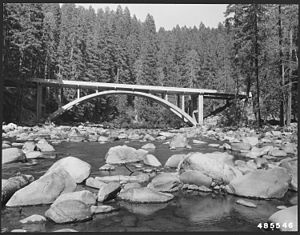| Collawash River | |
|---|---|
 A deck arch bridge over the river, pictured in 1957 | |
| Etymology | Perhaps for a Sahaptin leader whose name was sometimes written as Colwash[2] |
| Location | |
| Country | United States |
| State | Oregon |
| County | Clackamas |
| Physical characteristics | |
| Source | Confluence of Elk Lake Creek and East Fork Collawash River |
| • location | Cascade Range, Mount Hood National Forest, Clackamas County, Oregon |
| • coordinates | 44°53′42″N 122°00′16″W / 44.89500°N 122.00444°W[1] |
| • elevation | 2,312 ft (705 m)[3] |
| Mouth | Clackamas River |
• location | Mount Hood National Forest, Clackamas County, Oregon |
• coordinates | 45°01′52″N 122°03′41″W / 45.03111°N 122.06139°W[1] |
• elevation | 1,470 ft (450 m) |
| Length | 12 mi (19 km)[4] |
| Basin size | 150 sq mi (390 km2)[5] |
| Type | Scenic, Recreational |
| Designated | March 30, 2009 |
The Collawash River is a 12-mile (19 km) tributary of the Clackamas River in the U.S. state of Oregon. Formed by the confluence of Elk Lake Creek and the East Fork Collawash River in the Cascade Range, it flows generally north-northwest from source to mouth through the Mount Hood National Forest.[4][6] The largest tributary of the upper Clackamas, it provides about a third of bigger river's low-flow volume.[5] About 35 percent of its watershed of 150 square miles (390 km2) is protected as wilderness.[5]
Fish habitat in the watershed is rated good to excellent.[5] Catch-and-release fishing for trout is allowed on the main stem and the Hot Springs Fork tributary, but the streams are closed to fishing for salmon and steelhead.[7] For whitewater runners, the river is considered as two or three sections which range from class II to class V on the International Scale of River Difficulty. Suggested flow range is 500 to 1000 cubic feet per second (14 to 28 m³/s).[8][9][10]
- ^ a b "Collawash River". Geographic Names Information System (GNIS). United States Geological Survey. November 28, 1980. Retrieved June 28, 2009.
- ^ Bright, William (2004). Native American Placenames of the United States. Norman, Oklahoma: University of Oklahoma Press. p. 116. ISBN 0-8061-3576-X.
- ^ Google Earth elevation for GNIS coordinates
- ^ a b United States Geological Survey (USGS). "United States Geological Survey Topographic Map: Bull of the Woods and Fish Creek Mountain, Oregon, quadrants". TopoQuest. Retrieved June 28, 2009. The maps include river mile (RM) markers up to 12 miles (19 km), slightly downstream of the source.
- ^ a b c d Scott Bettin, Acting Fisheries Biologist (April 1, 1989). "Collawash River Falls Fish Passage Project, 1988 Annual Report" (PDF). Mount Hood National Forest. Retrieved June 28, 2009.[permanent dead link]
- ^ Oregon Atlas & Gazetteer (Map) (1991 ed.). DeLorme Mapping. § 55, 56, and 61. ISBN 0-89933-235-8.
- ^ Sheenan, Madelynne Diness (2005). Fishing in Oregon: The Complete Oregon Fishing Guide (10th edition). Scappoose, Oregon: Flying Pencil Publications. p. 126. ISBN 0-916473-15-5.
- ^ "Collawash, Oregon—Lake Creek to river mile 5.5". American Whitewater. June 11, 2005. Archived from the original on September 27, 2007. Retrieved August 15, 2007.
- ^ "Upper Collowash River". Oregon Kayaking. Retrieved August 15, 2007.
- ^ "Collawash, Oregon—Mile 5.5 bridge to Two Rivers Picnic Area". American Whitewater. June 11, 2005. Archived from the original on September 30, 2007. Retrieved August 15, 2007.
